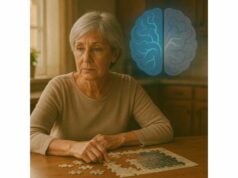
Aging brains are resilient, but they are also sensitive to medicines that block acetylcholine—a key chemical for attention, learning, and sleep architecture. The phrase “anticholinergic burden” describes the total load of these effects across all your prescriptions and over-the-counter products. That load can quietly accumulate through common drugs for bladder urgency, allergies, motion sickness, sleep, and irritable bowel symptoms. In midlife and later life, a high burden is linked to slower thinking, reduced alertness, constipation, dry mouth, blurry vision, falls, and—over years—greater risk of cognitive decline. This article explains what anticholinergic burden means, which medicines add up, how scoring tools work, and practical steps to reduce exposure without sacrificing symptom control. If you are building a broader plan for resilient cognition, see our practical guide to brain-protective habits at evidence-based strategies for protecting memory and mental performance.
Table of Contents
- What “Anticholinergic Burden” Means for Memory and Attention
- Common Culprits: Bladder, Allergy, Sleep, and GI Medications
- Scoring Tools (e.g., ACB) and How Cumulative Load Adds Up
- Deprescribing Basics: Stepwise Substitution and Taper Plans
- Safer Alternatives to Discuss and Non-Drug Approaches
- Monitoring Cognition and Function During Medication Changes
- When to Involve Specialists: Geriatrics, Psychiatry, or Neurology
What “Anticholinergic Burden” Means for Memory and Attention
Acetylcholine supports attention, working memory, learning, REM sleep regulation, and smooth communication among neurons. Medications with anticholinergic properties antagonize muscarinic receptors and blunt that signaling. A small acute dose can cause transient effects—sleepiness, slowed reaction time, dry mouth, constipation, and blurred near vision. Repeated exposure, higher doses, or combining multiple anticholinergic drugs increases the probability of daytime confusion, delirium during illness or hospitalization, and balance problems that raise fall risk.
In brain aging, why does this matter? Many adults in their 50s, 60s, and 70s take several medications. The total anticholinergic load from bladder antimuscarinics, first-generation antihistamines, some antidepressants, certain antipsychotics, muscle relaxants, antiemetics, and GI antispasmodics can push people over a symptomatic threshold. Because these drugs also decrease salivation and sweat and relax the ciliary muscle in the eye, they reduce contrast sensitivity and accommodation, which compounds reading and driving challenges in older adults. Central effects—slower processing speed, impaired divided attention, and reduced new learning—show up first under stress, during multitasking, or when sleep is poor.
Three practical points help patients and clinicians weigh risk:
- Dose and duration matter. A single bedtime dose of a sedating antihistamine for a cold is not the same as nightly use for sleep. Months of continuous exposure carry more cognitive risk than brief, targeted courses.
- Drug properties matter. Lipophilicity and ability to cross the blood–brain barrier differ widely. For example, some bladder antimuscarinics penetrate the CNS more readily than others. “Peripherally acting” agents or quaternary amines may have a lower likelihood of central effects, though dose still matters.
- Total burden matters. People rarely take just one anticholinergic. The sum across prescriptions and over-the-counter products—plus sedatives that worsen attention indirectly—best predicts day-to-day performance.
You do not need to memorize receptor pharmacology to act. The safest approach is to identify the contributors, lower the overall burden while maintaining symptom control, and monitor how thinking, mood, balance, and sleep respond. The rest of this guide offers a stepwise way to do that with your clinician.
Common Culprits: Bladder, Allergy, Sleep, and GI Medications
Many people discover their anticholinergic burden only after listing everything they take—including over-the-counter remedies, “PM” versions, and as-needed motion-sickness products. The usual suspects fall into four everyday categories:
1) Bladder antimuscarinics (overactive bladder, urgency):
Oxybutynin, tolterodine, solifenacin, fesoterodine, darifenacin, trospium. These can ease urgency and frequency but often cause dry mouth and constipation; some have greater potential to affect attention and memory at therapeutic doses, particularly with long-term, continuous use. Heat intolerance and decreased sweating can be problematic in warm weather.
2) Allergy and motion-sickness drugs (first-generation H1 antihistamines):
Diphenhydramine, doxylamine, chlorpheniramine, promethazine, hydroxyzine, meclizine, dimenhydrinate. These cross the blood–brain barrier readily and impair vigilance. “PM” on the label usually means diphenhydramine 25–50 mg added to a pain reliever. Many cold, cough, and sleep aids contain these agents in combination; people unintentionally double up across products.
3) Sleep aids and sedating antidepressants:
Diphenhydramine and doxylamine are common bedtime choices but are not designed for chronic insomnia. Tricyclic antidepressants (e.g., amitriptyline, imipramine) have strong anticholinergic activity; low-dose doxepin is a special case—≤6 mg nightly is generally considered acceptable for older adults, while >6 mg carries anticholinergic risk. Some antipsychotics also contribute substantially and should not be used solely for sleep.
4) GI antispasmodics and antiemetics:
Dicyclomine, hyoscyamine, scopolamine patches (for motion sickness), and certain phenothiazines used for nausea can add considerably to the anticholinergic load. In irritable bowel syndrome with diarrhea (IBS-D), these are often used “as needed,” but frequent dosing accumulates.
Other contributors worth flagging during a review include cyclobenzaprine (a muscle relaxant) and paroxetine (an SSRI with notable anticholinergic properties). The point is not to ban useful medicines; it is to spot chronic, avoidable exposure, especially when safer alternatives exist. If you are sorting out which symptoms stem from aging versus medications, this primer on how normal aging differs from disease can provide context for your next clinic visit.
Practical self-audit tips:
- Empty the medicine cabinet and write one list of everything you take, including topicals, patches, and supplements.
- Circle anything with “PM,” “nighttime,” “allergy,” “motion sickness,” “vertigo,” “bladder,” or “bloating/cramps.”
- Bring the list to your clinician or pharmacist; ask, “Which of these raise my anticholinergic burden?”
Scoring Tools (e.g., ACB) and How Cumulative Load Adds Up
Clinicians use structured lists to estimate anticholinergic load and compare options. Several tools exist; the Anticholinergic Cognitive Burden (ACB) scale is widely used in primary care and geriatrics. Others include the Anticholinergic Risk Scale (ARS), Anticholinergic Drug Scale (ADS), and the Drug Burden Index (DBI), which also captures sedative load.
How these tools typically work:
- Each medication receives a score—commonly 0 (no known activity), 1 (possible), 2 (definite), or 3 (definite with documented cognitive risk).
- Your total burden equals the sum across all current drugs. For many adults, the hidden risk appears not from a single “3-point” drug, but from several 1-point and 2-point agents stacked together.
- A higher total correlates with slower processing speed, more daytime sleepiness, poorer attention, and greater risk of falls and functional decline. In mobility studies, higher burden is linked with slower walking speed by roughly 0.08 m/s on average—small but clinically meaningful for fall risk and independence.
Examples (illustrative, not exhaustive):
- ACB ~3: oxybutynin, diphenhydramine, doxylamine, amitriptyline, paroxetine, scopolamine, dicyclomine, promethazine, hydroxyzine, meclizine.
- ACB ~1–2: some antipsychotics and muscle relaxants; scores vary by list and dose.
Scores are guides, not verdicts. They help frame a conversation: “Is there a non-anticholinergic option just as effective for me?” or “Can we reduce the dose or frequency without letting symptoms flare?” They also help prioritize changes: start with medications that contribute 3 points, have no strong current indication, or duplicate therapy (e.g., both a PM analgesic and a separate bedtime antihistamine).
Two cautions:
- Different scales may assign different scores to the same drug, and clinical context (dose, route, duration) matters.
- Anticholinergic burden is one piece of polypharmacy risk. Sedatives, opioids, and benzodiazepines can worsen attention and balance even without anticholinergic activity. If brain-barrier permeability and neuroinflammation interest you, this overview of blood–brain barrier factors explains why some drugs affect the CNS more than others.
The practical takeaway: Use a scale to estimate, then individualize decisions—aiming for the lowest effective burden that still controls your symptoms.
Deprescribing Basics: Stepwise Substitution and Taper Plans
Deprescribing means planned, supervised reduction or discontinuation of medicines that are unnecessary, duplicative, or more harmful than helpful. With anticholinergics, the goal is to lower cognitive and functional risk while maintaining symptom control. Here is a stepwise approach you can take to a clinic visit:
Step 1 — Inventory and prioritize.
List all medications (Rx and OTC) with doses and timing. Using a burden scale, flag 3-point contributors and chronic daily use. Identify therapeutic duplications (e.g., diphenhydramine at night plus a daytime hydroxyzine).
Step 2 — Clarify goals and alternatives.
For each target drug, write the symptom you are treating (e.g., “bladder urgency after 4 pm”), what success looks like, and which non-anticholinergic options could replace or reduce it (β3-agonists for bladder, second-generation antihistamines or nasal steroids for allergic rhinitis, CBT-I for insomnia, non-drug IBS strategies).
Step 3 — Choose the initial change.
Start with the highest-risk or lowest-benefit agent. Change one variable at a time when practical, so you can attribute outcomes.
Step 4 — Taper, don’t yank.
Abruptly stopping long-term anticholinergics can cause rebound symptoms (e.g., worse urgency, itching, nausea). Typical tapers (always individualized):
- Sedating antihistamines (diphenhydramine, doxylamine): reduce dose by 25–50% every 3–7 days, then switch to as-needed only, then stop.
- Tricyclics (amitriptyline): reduce by 10–25% of the daily dose every 1–2 weeks; slower near the end to minimize insomnia or headache.
- Bladder antimuscarinics: if switching to a β3-agonist, start the new agent first, then reduce the antimuscarinic over 2–4 weeks.
- GI antispasmodics (dicyclomine, hyoscyamine): convert chronic use to as-needed tied to predictable triggers, then taper frequency.
Step 5 — Add supportive measures.
Constipation and dry mouth may ease as doses come down, but hydration, fiber (20–30 g/day), a gentle osmotic laxative if needed, saliva substitutes, and sugar-free gum can help during the transition. Align sleep-wake timing and light exposure when tapering sedating antihistamines.
Step 6 — Track outcomes.
Use brief, repeatable measures (sleep diary, bladder diary, 10-meter walk speed, timed up-and-go, a 3-item recall) at baseline and at each adjustment. Pair medication changes with behavioral substitutes (pelvic floor training, nasal irrigation, CBT-I techniques). For people with anxiety or low mood, proactively plan supports; stepping down sedating drugs can unmask symptoms. Practical guidance on addressing mood symptoms will make deprescribing smoother.
When to pause or reverse: new confusion, severe rebound insomnia or urgency, falls, or a clear drop in function. In those cases, return to the previous effective dose and reassess the plan.
Safer Alternatives to Discuss and Non-Drug Approaches
The best substitute depends on the symptom you are treating. Aim for equal or better symptom control with a lower anticholinergic load, plus targeted non-drug strategies.
Bladder urgency/overactive bladder (OAB):
- β3-agonists: Mirabegron (often 25–50 mg once daily) and vibegron (75 mg once daily) do not block acetylcholine and have a more favorable cognitive profile. They can raise blood pressure slightly; periodic checks are sensible.
- Behavioral therapy: bladder training, pelvic-floor muscle training, limiting fluids 2–3 hours before bedtime, and treating constipation.
- Advanced options (for refractory cases): onabotulinumtoxinA injections or tibial/sacral neuromodulation after urology evaluation.
Allergic rhinitis/motion sickness:
- Second-generation antihistamines: cetirizine 5–10 mg, loratadine 10 mg, or fexofenadine 60–180 mg are less sedating and have minimal anticholinergic effect at standard doses.
- Intranasal therapies: corticosteroids (e.g., fluticasone), antihistamines (azelastine), saline irrigation.
- Motion sickness: emphasize non-drug strategies (seating position, horizon fixation, ventilation). If needed, use the lowest effective scopolamine exposure for the shortest time; avoid routine use in those with cognitive concerns.
Insomnia:
- First-line: CBT-I, sleep-schedule regularity, morning light, and stimulus control.
- Pharmacologic: consider melatonin (0.5–3 mg in early evening for phase advance; 1–5 mg around bedtime as a hypnotic) or low-dose doxepin (3–6 mg) if a medicine is required. Orexin antagonists (e.g., suvorexant, lemborexant, daridorexant) do not raise anticholinergic burden; monitor for next-day sleepiness and cost.
GI cramping/IBS:
- Diet and behavioral: identify trigger foods (FODMAP trial), regular meals, soluble fiber, peppermint oil enteric-coated capsules for cramping, stress-reduction techniques, gut-directed hypnotherapy.
- Targeted pharmacology: antidiarrheals/anticonstipation agents as indicated; reserve antispasmodics for intermittent use and avoid chronic daily dosing.
Anxiety or itch:
- For anxiety, favor SSRI/SNRI options with minimal anticholinergic activity (avoid paroxetine); use psychotherapy and skills training.
- For itch, prioritize topical therapy, moisturizers, and non-sedating antihistamines when appropriate; avoid nightly hydroxyzine unless benefits clearly outweigh risks.
Non-drug foundations—movement, sleep regularity, social connection, and cognitively engaging activities—make all medical changes work better. For ideas that also sharpen attention and balance, consider adding movement-plus-thinking routines to your week.
Monitoring Cognition and Function During Medication Changes
When you and your clinician adjust medicines, plan what to measure, when to measure it, and what success looks like. Keep the plan simple enough to follow at home.
Before the first change (baseline):
- Symptoms: a 1-week diary relevant to the target (bladder entries, nasal congestion scores, sleep logs).
- Cognition: a brief screen—Mini-Cog or 3-word recall with a clock drawing; if available, a more detailed tool like MoCA.
- Function and safety: gait speed over 4–10 meters, Timed Up-and-Go, and a falls log.
- Vitals and side effects: blood pressure/pulse (if adding a β3-agonist), bowel pattern, mouth/eye dryness, vision changes.
During taper or substitution:
- Check-ins at 2–4 weeks, then at 8–12 weeks. For each visit, repeat the same cognitive screen and functional measure. Expect small, incremental gains (e.g., a bit more alertness in the afternoon, fewer naps, steadier gait). Anticholinergic withdrawal may temporarily unmask anxiety or insomnia; address proactively with behavioral strategies and supportive therapies.
Markers of progress:
- Reduced daytime dozing and clearer attention during conversations.
- Fewer near-falls, steadier walking, quicker sit-to-stand.
- Improved recall on simple tests, better task sequencing (bills, cooking steps).
- Symptom control maintained with a lower overall anticholinergic score.
When to escalate evaluation:
- New or worsening confusion, hallucinations, agitation, or falls.
- Persistent bladder or GI symptoms despite optimized non-anticholinergic therapy.
- Suspicion of underlying neurodegenerative disease or a sleep disorder (e.g., untreated sleep apnea).
Consider adding home safety checks (lighting, contrast, grab bars) and vision/hearing reviews, since cumulative burden often converges with sensory loss to amplify confusion and risk. To track broader brain-health signals alongside medication changes, see how walking speed and reaction time relate to cognition in this primer on gait and reaction-time signals.
When to Involve Specialists: Geriatrics, Psychiatry, or Neurology
Geriatrics (or a clinical pharmacist with geriatric expertise):
Call in geriatrics when there is polypharmacy (≥5 drugs), repeated falls, unexplained weight loss, delirium during hospitalizations, or when multiple conditions compete (pain, insomnia, bladder urgency, mood). Geriatricians optimize regimens using Beers criteria, prioritize function, and coordinate deprescribing with safer substitutes. Medication reconciliation after every care transition is their specialty.
Psychiatry:
Involve a psychiatrist if anticholinergic contributors include antipsychotics, tricyclics, or paroxetine, or when tapering unmasks mood or anxiety disorders. Psychiatrists can pivot to lower-burden antidepressants, manage insomnia without sedating antihistamines, and supervise slow tapers from agents with withdrawal potential. They also help with behavioral therapies (CBT-I, CBT for anxiety) that replace sedating medications.
Neurology:
Consult neurology when there is progressive cognitive decline beyond medication effects, parkinsonism, frequent visual hallucinations, focal deficits, or unexplained imbalance. A neurologist can evaluate for mild cognitive impairment or dementia, advise whether certain agents are more problematic (e.g., anticholinergics in Lewy body disease), and coordinate with rehabilitation services to protect function during medication adjustments.
Co-management examples:
- Overactive bladder with cognitive concerns: Primary care and urology select a β3-agonist and pelvic-floor therapy; geriatrics monitors cognition and constipation; neurology becomes involved if cognitive screening worsens.
- Chronic insomnia plus anxiety: Psychiatry leads CBT-I and SSRI optimization; geriatrics structures the antihistamine taper; primary care monitors blood pressure and daytime function.
- IBS with cramping and frequent antispasmodic use: Gastroenterology optimizes diet and gut-directed therapy; geriatrics moderates anticholinergic exposure; neurology is consulted only if persistent cognitive complaints suggest a separate process.
Bring a single-page medication list (dose, time of day, indication) to new visits, and explicitly note which medicines you prefer to avoid because of cognition. Ask that preference to be added to your chart so future prescribers see it.
References
- American Geriatrics Society 2023 updated AGS Beers Criteria® for potentially inappropriate medication use in older adults 2023 (Guideline)
- The AUA/SUFU Guideline on the Diagnosis and Treatment of Idiopathic Overactive Bladder (2024) 2024 (Guideline)
- Anticholinergic drugs and the risk of dementia: A systematic review and meta-analysis 2021 (Systematic Review)
- The association between anticholinergic burden and mobility: a systematic review and meta-analyses 2023 (Systematic Review)
- SUFU white paper on overactive bladder anticholinergic medications and dementia risk 2022 (Guideline)
Disclaimer
This information is educational and is not a substitute for personalized medical advice, diagnosis, or treatment. Medication decisions—including deprescribing—should be made with a qualified clinician who understands your health history, current prescriptions, and priorities. If you have sudden confusion, falls, or severe symptom rebound during medication changes, seek medical care promptly.
If you found this article useful, please consider sharing it on Facebook, X (formerly Twitter), or your preferred platform, and follow us for future updates. Your support helps us continue producing high-quality, evidence-based content.










